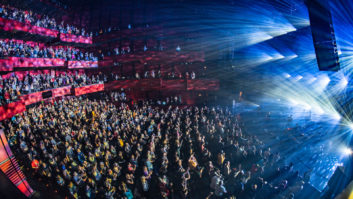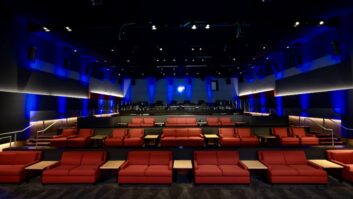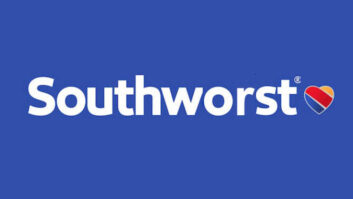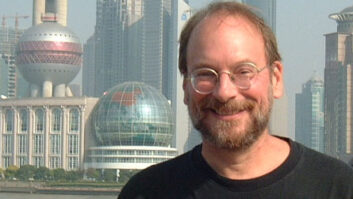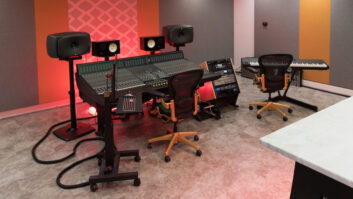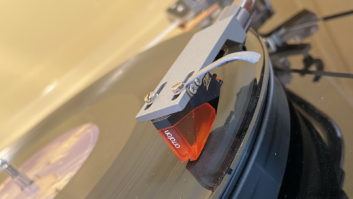There is an axiom in the sound contracting industry that the goal is to sell a house of worship its last sound system. The adage, first coined decades ago, recognizes that a church sound system will go through one or more iterations before the best possible solution is installed, for a variety of reasons, including inexperience on the part of the contractor, the worship team, or both; changes to the type of services; improvements in audio technology; and, as often as not, insufficient budget.
The VUE Audiotechnik line array system installed at Mountain View, CA’s Mountain View New Community Baptist Church was part of an extensive audio overhaul. When Michael S. Yoo, senior system engineer with Genesis Technology, LLC in Ashburn, VA visited Mountain View New Community Baptist Church three years ago, the sound system comprised just two small, ceiling-mounted point source speakers. “They were pointing towards the back wall, so the sound was terrible—really, really bad,” he recalls, noting that the church, located in Mountain View, CA, also had two powered speakers on sticks for coverage. Yoo started designing a new system with the church two years ago while it worked on getting the funding together.

The construction of the space, measuring about 80 feet by 80 feet, plus the location of two large video screens, limited the flying options for the replacement system, a line array from VUE Audiotechnik. “The senior pastor and all the leaders didn’t want anything to obstruct the video screens,” he says.
The solution was two hangs each of eight VUE al-4 subcompact line array boxes, powered by a pair of V4 System Engines, four-channel amplifiers with integrated 64-bit DSP, each capable of driving up to eight cabinets. Custom painted in white, the arrays are unobtrusively flown in front of large pillars either side of the screens. The flown system is complemented by a pair of self-powered VUE hs-25 dual 15-inch ACM (Active Compliance Management, VUE’s hybrid design combining both band-pass and vented alignments) subwoofers on the floor.
Yoo notes that the Ethernet capabilities of both the Midas Pro2 console that he supplied for front-of-house and the VUE system enabled him to network the system at 96 kHz, AES/EBU. The system also includes a Shure ULX-D digital wireless microphone set-up.
“All the processing is being done in the V4s. Because we can control those over Ethernet, it was very easy to tune the system. We could just hook up a laptop and control even the subwoofers using the SystemVUE audio software; the program is very easy to use,” says Yoo.
A mix of JBL loudspeakers and Community subwoofers are used inside the new 1,400-capacity Liberty Baptist Church in Spring Lake, NC. “One thing that really surprised us was how clear it was, even when you were sitting far left or far right. They were thinking about using the old speakers as side fills if they had to, but once we tuned the system, there was no need to use them.”

In 2004, G. Michael Melcher, president of Revelation Sound, Inc. (RSI) in Miami, FL, provided acoustic consulting and A/V design services to the 1,400-seat Church of St. Bonaventure in Davie, FL. The church wanted a system suitable for both speech and music, specifically seven different choirs, dictating a digitally-controlled system with a variety of choir presets, which RSI designed and built with wireless touchscreen control. The distributed point source system comprises 10 Renkus-Heinz CT-328 speakers and a single CT-5212 speaker powered by Crown amplifiers with Peavey processing.
“We had lost contact with the church leadership and several other companies came in and ‘re-did’ our work,” says Melcher. “After two years of difficulties, the priest called us back to restore his church to the excellent sound they originally had.”
Melcher had previously worked on a project with Robert Bernecker of SEFI Consulting in Waxahachie, TX, an expert in system tuning, and asked him to assist with re-commissioning this church’s system. “He did, and the result was nothing short of fantastic,” Melcher reports.
RSI began by upgrading the processor to a Symetrix Radius 12×8 EX. “New DSP and algorithms work better than older ones,” he comments. “The Symetrix unit allowed us to implement several custom FIR filter blocks—SysTune and Filter Hose—and timing schemes.”
At the Metro City Church, located in the Detroit metropolitan area, 1,500 people each weekend hear services through a hybrid D.A.S. Aero system. The experience demonstrated a number of things, he says. “A good design remains a good design throughout its life. We designed a good system in 2004; it worked very well then with the tech available.”

While the speakers might be considered old by some, “Mr. Ralph Heinz designed an excellent loudspeaker in the CT series. They responded very well to IR-based commissioning and ‘phase tuning,’ flat-phase FIR filters. Well-designed speakers work better and better as processing tech develops.”
According to Melcher, “Overall levels were dropped with evenness, and coverage and clarity improved considerably. The priest said that the result raised the hairs on the back of his neck.” Best of all, he says, “We reacquired our customer and are now upgrading sound systems in their parish center and chapel.”
Design-build firm Tri-Tronics Pro Electronics, located in Lillington, NC, completed installation of a comprehensive sound, lighting and video system at the newly constructed, 1,400-capacity Liberty Baptist Church in Spring Lake, NC at the end of September. As Aaron Todd, CTS, system designer at Tri-Tronics, observes, the orientation of the seating and the size of the stage are somewhat unusual. “The main room is 110 feet wide and 75 feet deep, but the stage is 35 feet deep; it’s a very big stage for the space.”
The choice of main speakers was dictated by the church staff. “They were using a pair of JBL CBTs in a space that they were using temporarily. They fell in love with those speakers,” Todd reports.
Tri-Tronics rigged three JBL CBT70J speakers in an LCR configuration at about 18 feet. “We did an EASE drawing to make sure they would cover; they work well in there. As you get closer, it’s a wider pattern,” explains Todd. JBL’s Constant Beam-width Technology offers asymmetrical vertical coverage, delivering more sound to the rear of a room in order to create more consistent front-to-back levels.
A pair of Community iLF218W dual 18-inch subwoofers are flown either side of the center column. A BSS Sound-web London BLU-100 handles speaker management. The system is powered by QSC Audio RMX4050A and RMX2450 amplifiers, with two RMX850 amps driving the stage monitors.
“We’ve used those Community subs on several different projects, most of the time with other Community loudspeakers,” says Todd. “They sound really good to us. They really move the air. It’s a very contemporary service and they wanted to be able to really feel the low end. With two of those things, they really get the room rockin’.”
The 1,400-seat Church of St. Bonaventure in Davie, FL is covered by an extensive Renkus-Heinz distributed point source system. The church also had strong ideas about the management of inputs from the stage to the Allan & Heath GLD digital console at front-of-house, according to Todd. “There are no pockets, no jacks or anything on stage. That’s the way that they wanted it.”

Instead, a rack containing an A&H AudioRack AR2412 (24×12) and AR84 (8×4) expander can be wheeled onto the stage and connected over Cat 5 cable, or may be positioned out of sight backstage for all-wireless performances. “From that rack, they can plug-in however they want for however they have the layout for that Sunday,” says Todd. “They change things around a whole lot—that’s why they wanted that flexibility.”
Metro City Church, located in the Detroit metropolitan area, is a very modern organization, employing the latest technology and media—especially music—to engage its congregation, which reportedly numbers about 1,500 people each weekend. Having previously outfitted the 900-seat sanctuary at its original campus in Taylor, MI, with assistance from Guitar Center Professional (GC Pro), the church went back to the retailer to equip its new campus in the southern Detroit suburb of Riverview.
Toward the end of 2012, Paul Johnson, GC Pro senior account manager in Detroit, together with Paul Long, a Guitar Center sales associate based at the Southfield, MI store, in collaboration with Steve Trimble, D.A.S. Audio regional sales manager, designed and installed a new sound system for the church after carefully considering the available options. Long is also on staff at Metro City as the church’s lead sound engineer.
According to Long, “The church is very active with music, bringing bands in as well as it sending its own bands out for probably 10 years now, so we see a lot of the equipment that’s being used. There were really three major companies—the top three brands that we’ve worked with on tours—that we were looking at, including D.A.S.”
The sanctuary at the church’s Taylor campus features D.A.S. Aero Series 2 powered line array components flown in an LCR configuration—three cabinets in the center with six hung at either side of the stage. Two D.A.S. LX-215A powered band-pass subwoofers and eight LX-218CA dual-18-inch high performance powered subwoofers are stacked to the left and right, and are configured in cardioid arrays in order to reduce standing waves on the stage.
The rig has been so successful that a similar setup was ordered for the church’s new Riverview campus, including a total of 15 D.A.S. Aero 12A line array modules flown in an LCR configuration, and a dozen LX-218CA dual-18-inch subs, along with dbx DriveRack VENU360 speaker processing.
The systems at both campuses are very similar, says Long, “But one thing that is a bit different is that we originally sold them Aero 12As and they have since modified and upgraded the system to include Aero 38As as well as Aero 12s, so it’s more of a hybrid system now.” The powered three-way Aero 38A module houses two 12-inch and two 10-inch speakers plus a 1.5-inch high frequency compression driver.
First U.S. Nexo STM Church Install
REDMOND, WA—Overlake Christian Church (OCC) in Redmond WA recently replaced the original PA in its 20-year-old, 5,000-seat sanctuary with a new Nexo STM line array system—the first to be installed in a house of worship in the U.S. System design and installation was tackled by Morgan Sound (Lynnwood, WA) following a comprehensive study of the acoustical space and available rigging points.
Overlake Christian Church’s new Nexo/Yamaha audio system. The main STM system consists of 10 Nexo M46 mid-high modules coupled with 10 B112 low-frequency modules per cluster in a Left-Right configuration. A trio of Nexo M28 down fill speakers per side are attached under the main arrays. A pair of three-box Nexo Geo S1230 speaker clusters were installed for balcony outfill, and a dozen Nexo S118 subwoofers were flown in the center of the church in cardioid mode to facilitate coverage throughout the whole space. The amplifier complement includes 13 Nexo NXAMP 4×4 and two each NXAMP 4×1 amplifiers for a total of 212,800 watts of power. All the amplifiers are connected via Dante.

Morgan Sound also installed a Yamaha CL5 digital audio console at front of house and a second on stage in the monitor position. Two Rio3224-D input/output boxes are used as the snake system. With Dante networking, the CLs are routinely used for multi-track recording and virtual sound check. Dante also connects to a DM1000 with a Dante MY card in the broadcast booth for additional recording capability.
A Yamaha DME64 digital mix engine was installed to provide signal distribution and EQ. “OCC is heavily invested in Yamaha products,” notes Weeks. The previous sanctuary console was a Yamaha PM1D. There is also an assortment of LS9 and M7CL digital audio consoles within other areas of the church.

